Abstract
34 preterm infants with birthweights <1200 g were randomly assigned to total parenteral nutrition (TPN) or oral (Milk) feeding regimens for the first 2 weeks after birth. Infants in the TPN group were started on a modified Vamin-based glucose amino-acid infusion and Intralipid. The daily amounts of carbohydrate, amino-acids, and fat infusions were increased. In the Milk group, infants were started on intermittent gavage feeding, supplemented with a glucose-electrolyte infusion as necessary. The overall mortality rate did not differ in the two groups. Four infants in the Milk group developed necrotising enterocolitis but none did in the TPN group. Despite mean daily energy intakes which were not greatly different, there were much higher mean daily intakes of carbohydrate and protein in the TPN group compared with the Milk group. Fat intake in the TPN group was lower than in the Milk group in the 1st week because of neonatal jaundice which contraindicated the use of Intralipid. There was no difference in the mean daily fat intake by the 2nd week. Although mean daily weight loss in the 1st week and the maximum postnatal weight loss in the two groups were similar, infants in the TPN group had a greater mean daily weight gain in the 2nd week and took less time to regain and maintain birthweight. Metabolic complications were equally common in both groups and were reversible with early recognition. Limits of tolerance for water and most nutrients tended to be variable and the nutritional programme had to be adjusted for each baby. Nevertheless, we found that TPN, when properly managed, is an effective and safe procedure in very low birthweight infants.
Full text
PDF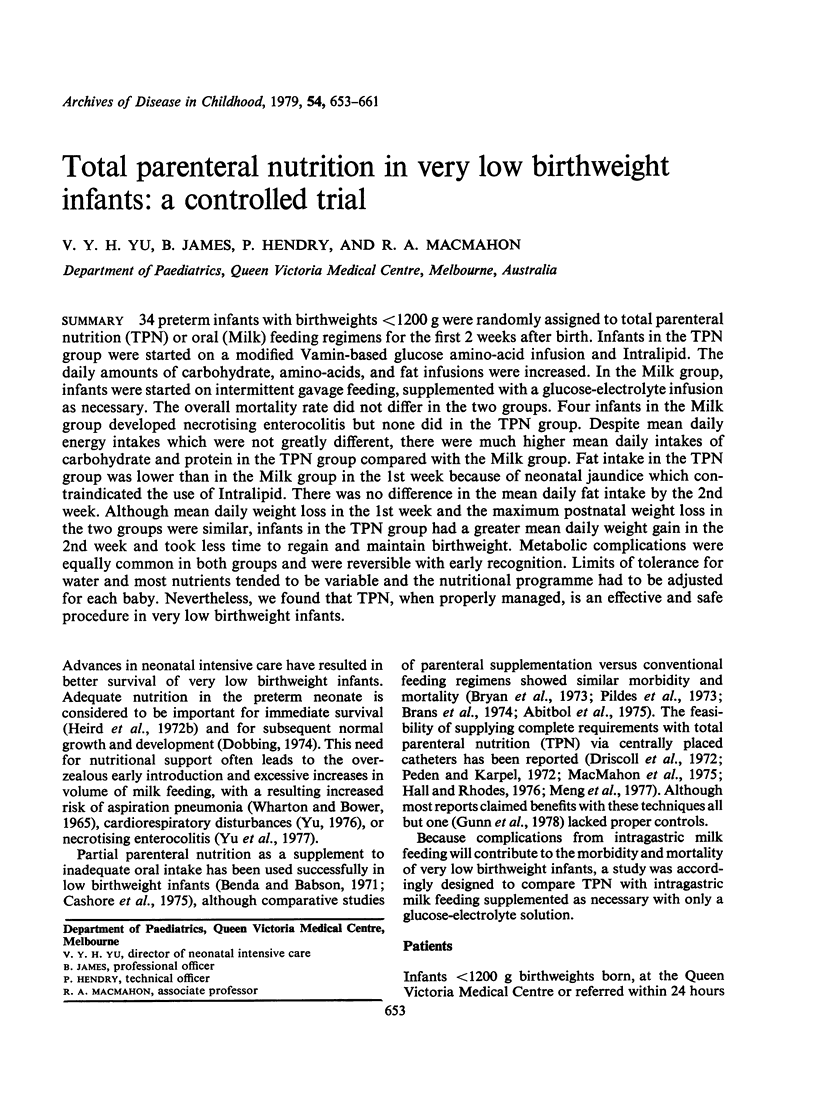
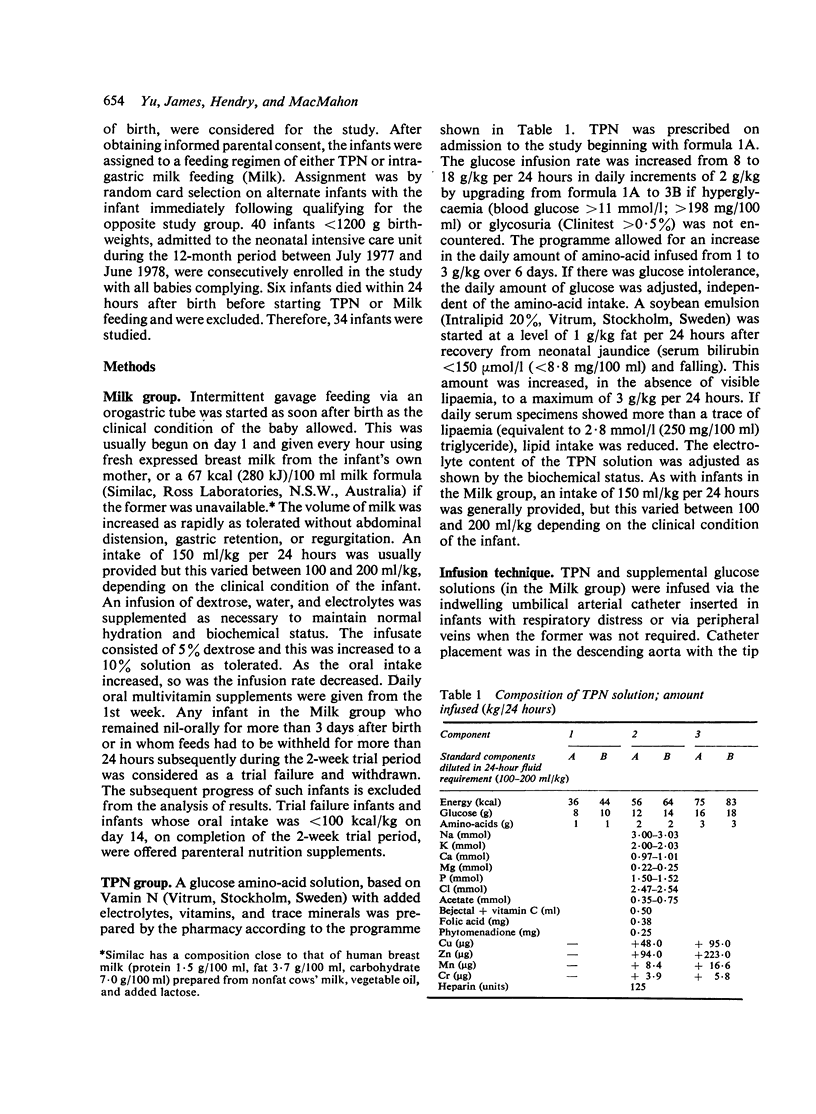
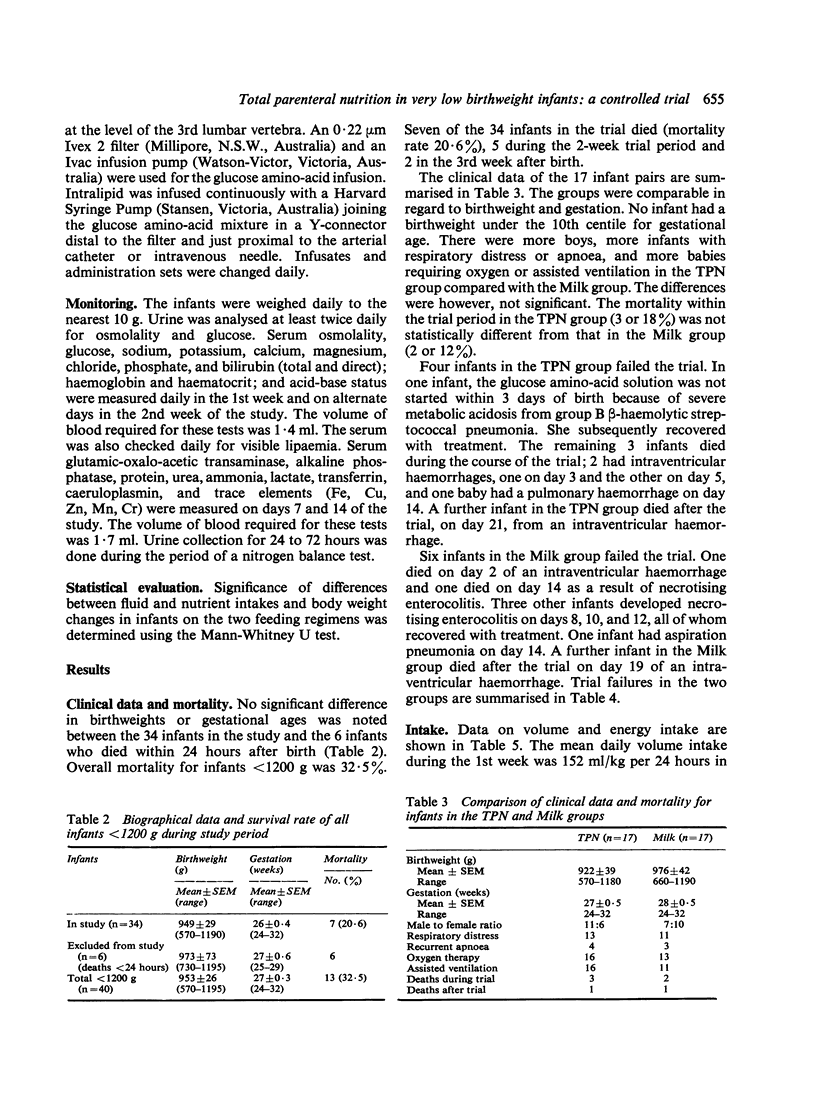
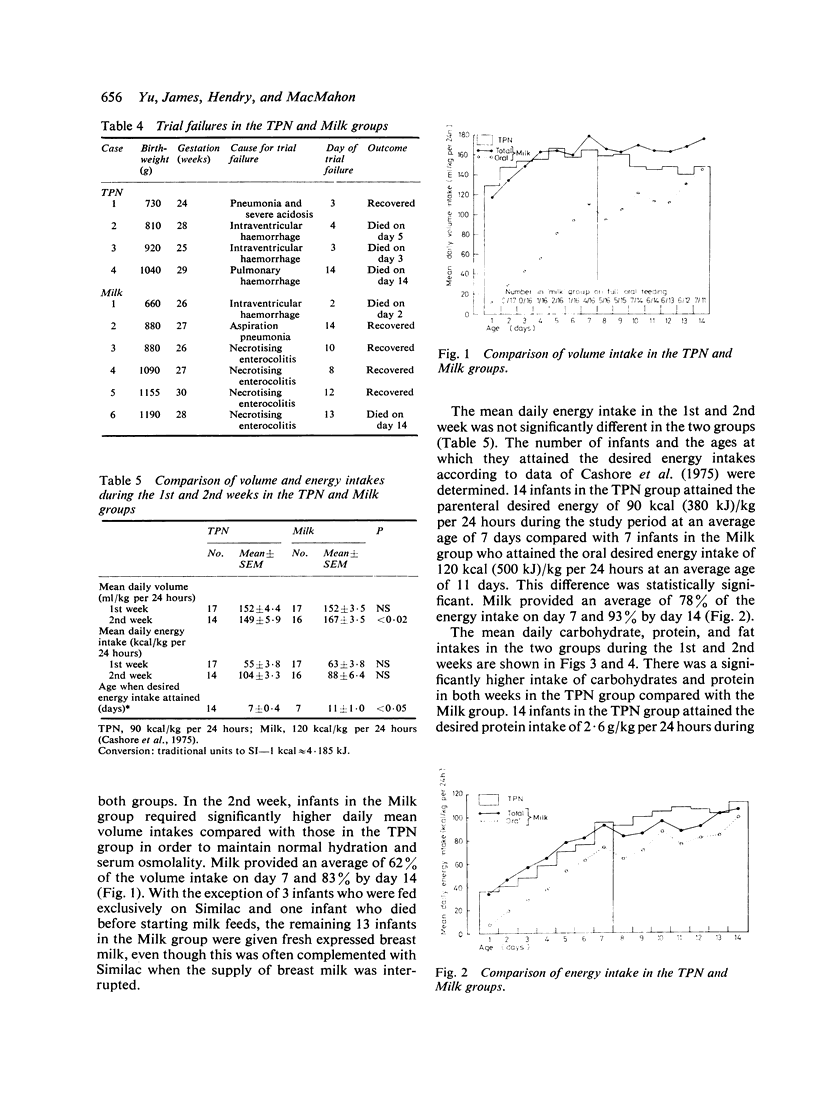

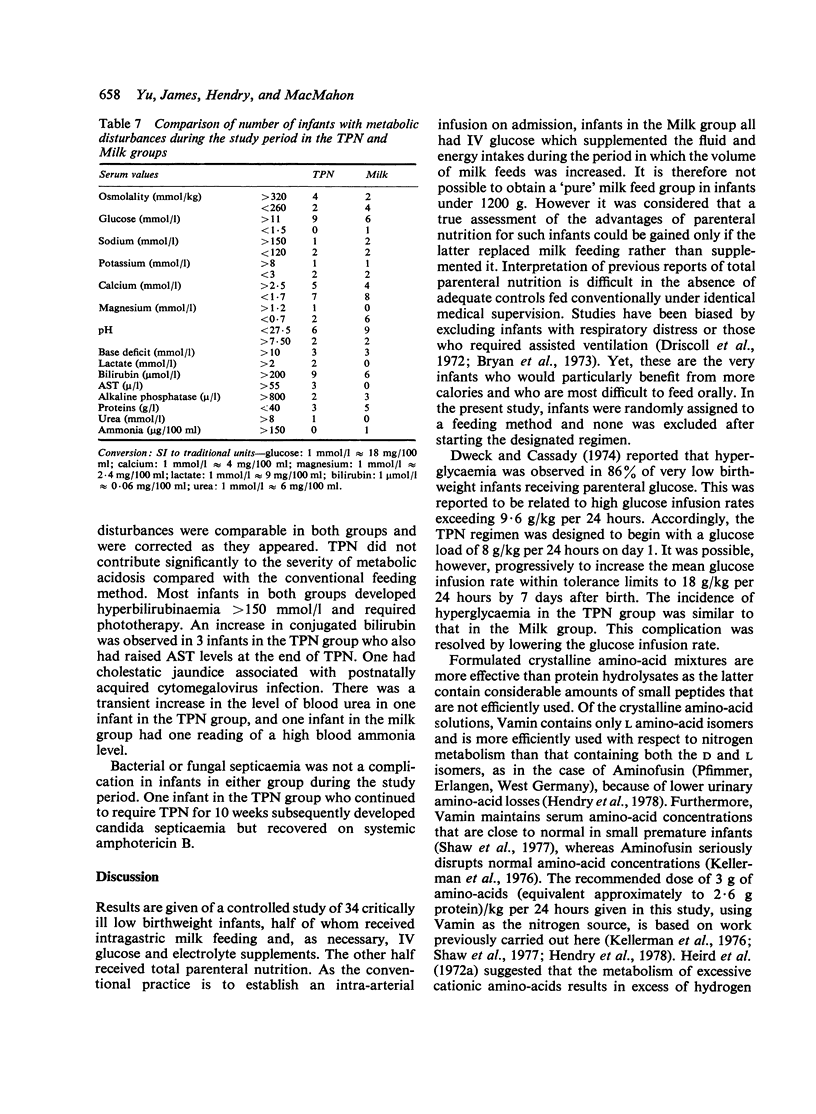
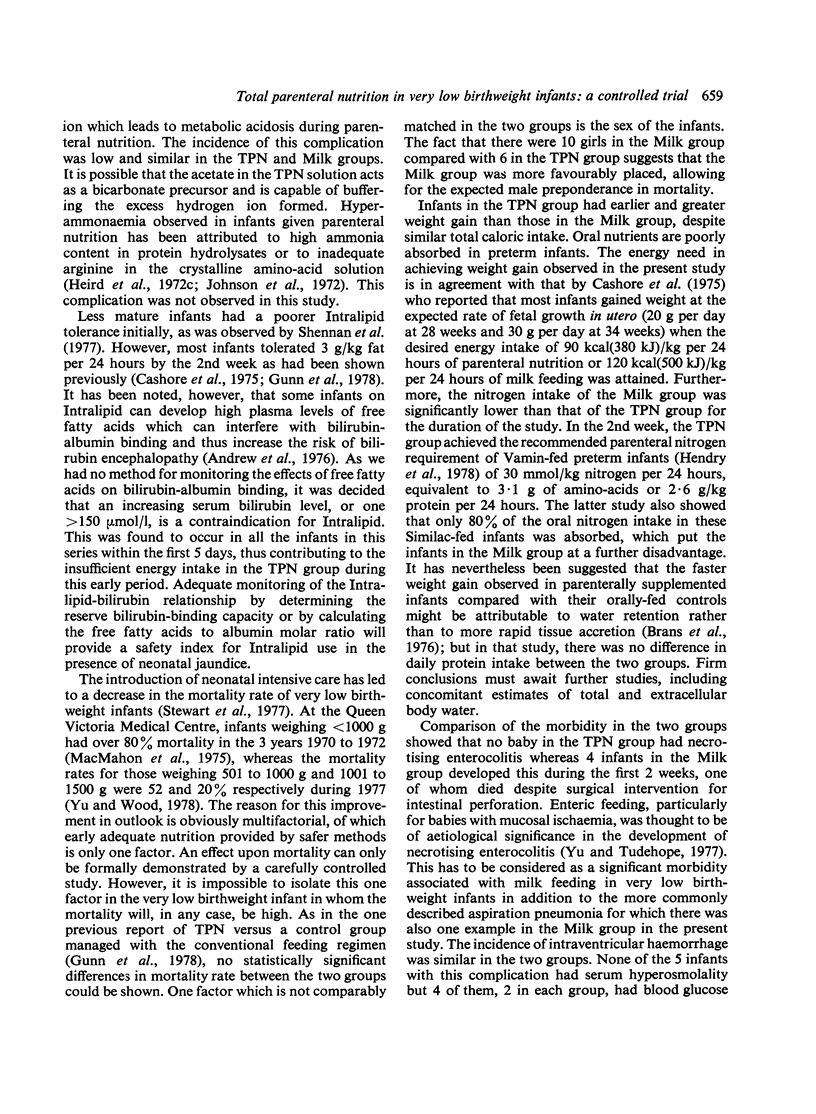
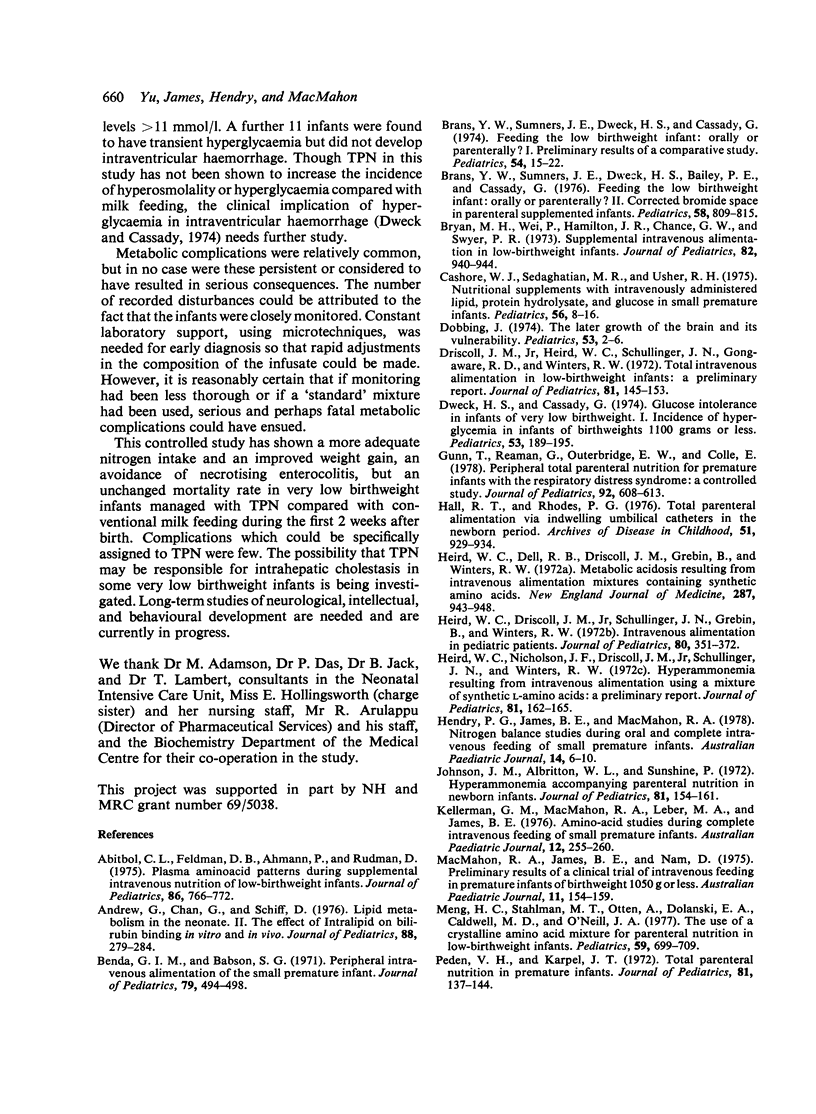
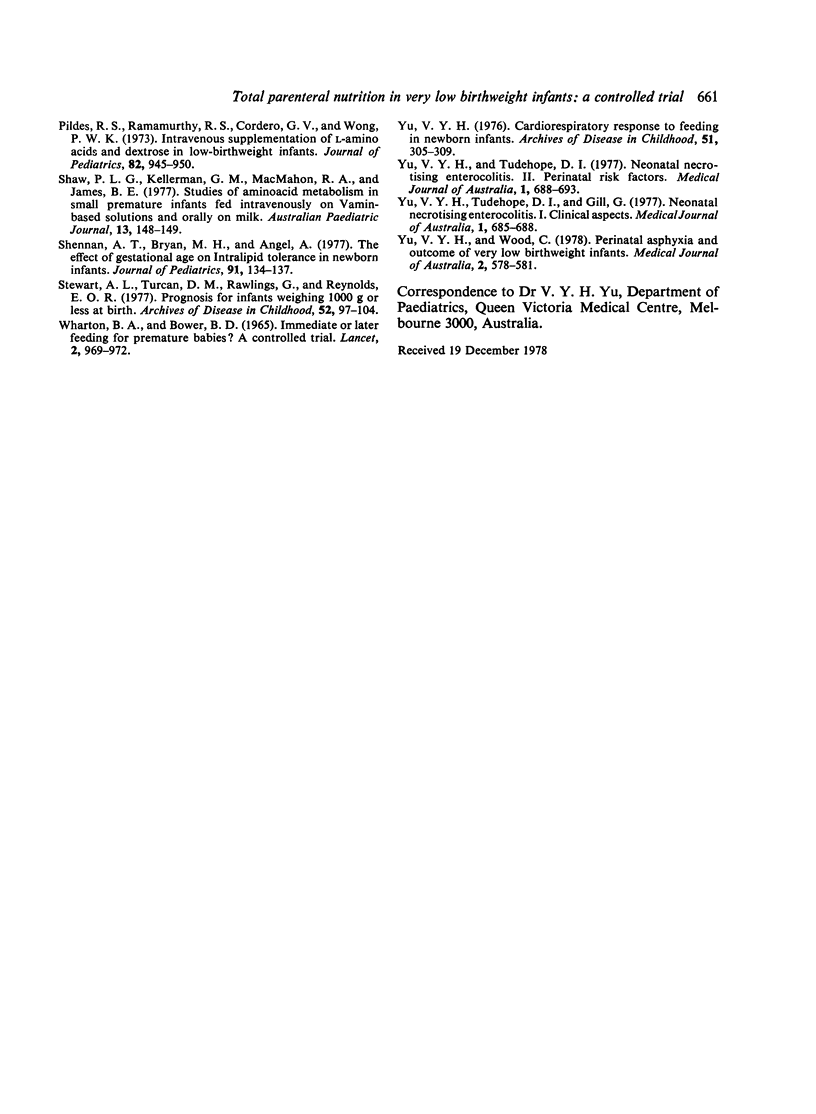
Selected References
These references are in PubMed. This may not be the complete list of references from this article.
- Abitbol C. L., Feldman D. B., Ahmann P., Rudman D. Plasma amino acid patterns during supplemental intravenous nutrition of low-birth-weight infants. J Pediatr. 1975 May;86(5):766–772. doi: 10.1016/s0022-3476(75)80369-6. [DOI] [PubMed] [Google Scholar]
- Andrew G., Chan G., Schiff D. Lipid metabolism in the neonate. II. The effect of Intralipid on bilirubin binding in vitro and in vivo. J Pediatr. 1976 Feb;88(2):279–284. [PubMed] [Google Scholar]
- Benda G. I., Babson S. G. Peripheral intravenous alimentation of the small premature infant. J Pediatr. 1971 Sep;79(3):494–498. doi: 10.1016/s0022-3476(71)80165-8. [DOI] [PubMed] [Google Scholar]
- Brans Y. W., Sumners J. E., Dweck H. S., Bailey P. E., Cassady G. Feeding the low-birthweight infant: orally or parenterally?: II. Corrected bromide space in parenterally supplemented infants. Pediatrics. 1976 Dec;58(6):809–815. [PubMed] [Google Scholar]
- Brans Y. W., Sumners J. E., Dweck H. S., Cassady G. Feeding the low birth weight infant: orally or parenterally? Preliminary results of a comparative study. Pediatrics. 1974 Jul;54(1):15–22. [PubMed] [Google Scholar]
- Bryan M. H., Wei P., Hamilton J. R., Chance G. W., Swyer P. R. Supplemental intravenous alimentation in low-birth-weight infants. J Pediatr. 1973 Jun;82(6):940–944. doi: 10.1016/s0022-3476(73)80421-4. [DOI] [PubMed] [Google Scholar]
- Cashore W. J., Sedaghatian M. R., Usher R. H. Nutritional supplements with intravenously administered lipid, protein hydrolysate, and glucose in small premature infants. Pediatrics. 1975 Jul;56(1):8–16. [PubMed] [Google Scholar]
- Dobbing J. The later growth of the brain and its vulnerability. Pediatrics. 1974 Jan;53(1):2–6. [PubMed] [Google Scholar]
- Driscoll J. M., Jr, Heird W. C., Schullinger J. N., Gongaware R. D., Winters R. W. Total intravenous alimentation in low-birth-weight infants: a preliminary report. J Pediatr. 1972 Jul;81(1):145–153. doi: 10.1016/s0022-3476(72)80394-9. [DOI] [PubMed] [Google Scholar]
- Dweck H. S., Cassady G. Glucose intolerance in infants of very low birth weight. I. Incidence of hyperglycemia in infants of birth weights 1,100 grams or less. Pediatrics. 1974 Feb;53(2):189–195. [PubMed] [Google Scholar]
- Gunn T., Reaman G., Outerbridge E. W., Colle E. Peripheral total parenteral nutrition for premature infants with the respiratory distress syndrome: a controlled study. J Pediatr. 1978 Apr;92(4):608–613. doi: 10.1016/s0022-3476(78)80304-7. [DOI] [PubMed] [Google Scholar]
- Hall R. T., Rhodes P. G. Total parenteral alimentation via indwelling umbilical catheters in the newborn period. Arch Dis Child. 1976 Dec;51(12):929–934. doi: 10.1136/adc.51.12.929. [DOI] [PMC free article] [PubMed] [Google Scholar]
- Heird W. C., Dell R. B., Driscoll J. M., Jr, Grebin B., Winters R. W. Metabolic acidosis resulting from intravenous alimentation mixtures containing synthetic amino acids. N Engl J Med. 1972 Nov 9;287(19):943–948. doi: 10.1056/NEJM197211092871901. [DOI] [PubMed] [Google Scholar]
- Heird W. C., Driscoll J. M., Jr, Schullinger J. N., Grebin B., Winters R. W. Intravenous alimentation in pediatric patients. J Pediatr. 1972 Mar;80(3):351–372. doi: 10.1016/s0022-3476(72)80492-x. [DOI] [PubMed] [Google Scholar]
- Heird W. C., Nicholson J. F., Driscoll J. M., Jr, Schullinger J. N., Winters R. W. Hyperammonemia resulting from intravenous alimentation using a mixture of synthetic l-amino acids: a preliminary report. J Pediatr. 1972 Jul;81(1):162–165. doi: 10.1016/s0022-3476(72)80396-2. [DOI] [PubMed] [Google Scholar]
- Hendry P. G., James B. E., MacMahon R. A. Nitrogen balance studies during oral and complete intravenous feeding of small premature infants. Aust Paediatr J. 1978 Mar;14(1):6–10. doi: 10.1111/j.1440-1754.1978.tb02931.x. [DOI] [PubMed] [Google Scholar]
- Johnson J. D., Albritton W. L., Sunshine P. Hyperammonemia accompanying parenteral nutrition in newborn infants. J Pediatr. 1972 Jul;81(1):154–161. doi: 10.1016/s0022-3476(72)80395-0. [DOI] [PubMed] [Google Scholar]
- Kellerman G. M., Macmahon R. A., Leber M. H., James B. E. Amino acid studies during complete intravenous feeding of small premature infants. Aust Paediatr J. 1976 Dec;12(4):255–260. doi: 10.1111/j.1440-1754.1976.tb02512.x. [DOI] [PubMed] [Google Scholar]
- MacMahon R. A., James B. E., Nam D. Preliminary results of a clinical trial of intravenous feeding of premature infants of birth weight 1050g or less. Aust Paediatr J. 1975 Sep;11(3):154–159. doi: 10.1111/j.1440-1754.1975.tb02303.x. [DOI] [PubMed] [Google Scholar]
- Meng H. C., Stahlman M. T., Otten A., Dolanski E. A., Caldwell M. D., O'Neill J. A. The use of a crystalline amino acid mixture for parenteral nutrition in low-birth-weight infants. Pediatrics. 1977 May;59(5):699–709. [PubMed] [Google Scholar]
- Peden V. H., Karpel J. T. Total parenteral nutrition in premature infants. J Pediatr. 1972 Jul;81(1):137–144. doi: 10.1016/s0022-3476(72)80393-7. [DOI] [PubMed] [Google Scholar]
- Pildes R. S., Ramamurthy R. S., Cordero G. V., Wong P. W. Intravenous supplementation of L-amino acids and dextrose in low-birth-weight infants. J Pediatr. 1973 Jun;82(6):945–950. doi: 10.1016/s0022-3476(73)80422-6. [DOI] [PubMed] [Google Scholar]
- Shennan A. T., Bryan M. H., Angel A. The effect of gestational age on intralipid tolerance in newborn infants. J Pediatr. 1977 Jul;91(1):134–137. doi: 10.1016/s0022-3476(77)80465-4. [DOI] [PubMed] [Google Scholar]
- Stewart A. L., Turcan D. M., Rawlings G., Reynolds E. O. Prognosis for infants weighing 1000 g or less at birth. Arch Dis Child. 1977 Feb;52(2):97–104. doi: 10.1136/adc.52.2.97. [DOI] [PMC free article] [PubMed] [Google Scholar]
- Yu V. Y. Cardiorespiratory response to feeding in newborn infants. Arch Dis Child. 1976 Apr;51(4):305–309. doi: 10.1136/adc.51.4.305. [DOI] [PMC free article] [PubMed] [Google Scholar]
- Yu V. Y., Tudehope D. I., Gill G. J. Neonatal necrotizing enterocolitis: 1. Clinical aspects. Med J Aust. 1977 May 7;1(19):685–688. doi: 10.5694/j.1326-5377.1977.tb131028.x. [DOI] [PubMed] [Google Scholar]
- Yu V. Y., Tudehope D. I. Neonatal necrotizing enterocolitis: 2. Perinatal risk factors. Med J Aust. 1977 May 7;1(19):688–693. doi: 10.5694/j.1326-5377.1977.tb131029.x. [DOI] [PubMed] [Google Scholar]
- Yu V. Y., Wood C. Perinatal asphyxia and outcome of very low birthweight infants. Med J Aust. 1978 Dec 16;2(13):578–581. doi: 10.5694/j.1326-5377.1978.tb131746.x. [DOI] [PubMed] [Google Scholar]


